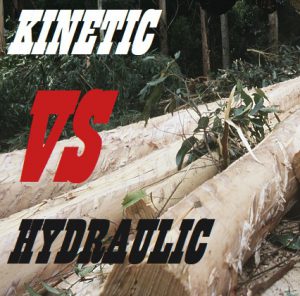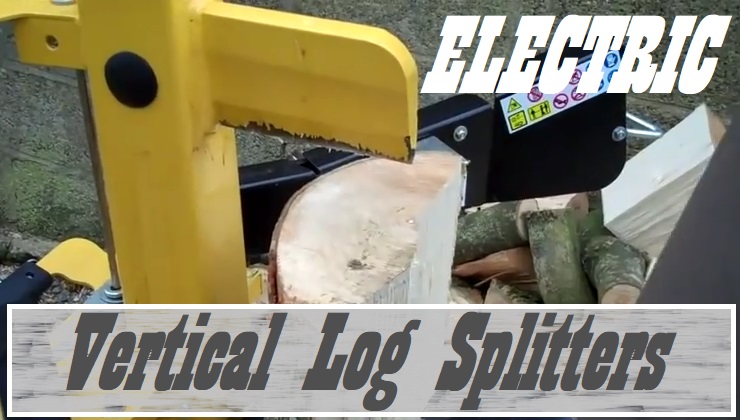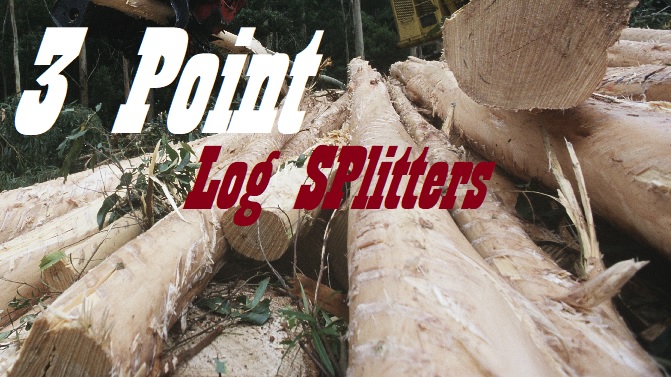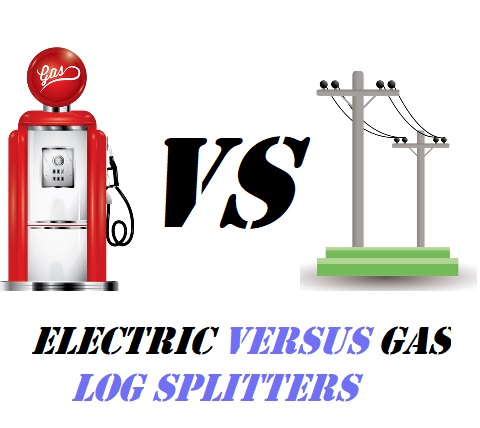I hope you love the products I've recommended below, just a heads up that as an Amazon associate, I earn from qualifying purchases. This means I may earn commissions on products bought via links on this page.
When it comes to choosing a log splitter it can get very overwhelming very quickly with all the different options and models on the market. One of the first choices you will have to make is hydraulic vs kinetic log splitters, which is better?. This is certainly not an easy to choice to make. Especially if you’re not use to using log splitters.
There are a few important differences between hydraulic versus kinetic splitters that you need to be aware of. These attributes are what make them stand out from the crowd. What may work for one may not work for another, so on this list I have chosen one model of each that I consider to be two of the very best entry-level splitters.
But before I reveal my personal favorites, lets take a look at some of the pros and cons of both types of wood splitting machines.
Compare Hydraulic And Kinetic Cycle Times
Type |
Cycle Time |
Ton Rating |
Our Rating |
Price | |
|---|---|---|---|---|---|
| Generac G10 | Kinetic | 1 Second | 10 | 9/10 | Check Price Amazon |
| Swisher Brute | Electric | 13 Seconds | 22 | 9.5/10 | Check Price Amazon |
| YardMax Full Beam | Gas | 9.7 Seconds | 25 | 8.5/10 | Check Price Amazon |
| Timber Champ | Kinetic | 2 Seconds | 7 Ton | 7.7/10 | Check Price Amazon |
| Stark | Kinetic | 2 Seconds | 7 Ton | 7/10 | Check Price Amazon |
The Pros And Cons Of Hydraulic Log Splitters
The most common type of you will come across when looking into splitters will most likely big a gas-powered hydraulic splitter. Which is for very good reason. They are big, they are powerful and they leave no log un-split.
There are a lot of advantages to hydraulic log splitters, with very few drawbacks. Which is why they are the most common type people buy when needing to split wood.
The most obvious and biggest advantage to hydraulic log splitters, is that generally they are a lot more powerful, and can split larger logs then their kinetic counterparts. Hydraulic systems have an easier time getting through knotty woods, and will struggle far less on hard woods.
The hydraulic splitter I have chosen for this list doesn’t have a vertical position, which for some may be a deal-breaker. The vertical position allows you to split much larger logs than a horizontal only splitting machine. For me personally, a log splitter that has a vertical position instantly increases its value.
Not just because when in a vertical position you can split larger diameter logs. But because you will also help your back in the long run. This is because you won’t have to lift the heavy logs up onto the horizontal bench. You can just roll a log into position then start splitting and only adjust in between cycles, which makes the chore a little less labor-intensive.
Those are just some of the pros of the hydraulic variety, so I feel I must mention the cons as well. Which thankfully, there aren’t too many. The big thing with hydraulic splitters is generally they have a higher up front cost then kinetic. But also require more maintenance as any engine based machine does. Even with a higher up front cost, I still believe they are worth the money just from the labor alone.
The next drawback is that compared to a kinetic splitter, a hydraulic splitter is slower per cycle. Kinetics are hands down the fastest type of log splitter on the current market.So while not to many down sides to hydraulic splitters, there is still some room for improvement.
The Pros And Cons Of Kinetic Log Splitters
Kinetic log splitters aren’t as common as hydraulic, but they are starting to make a bit of a resurgence lately and the main reason behind that is speed. With how busy everyone is lately it never seems like we have enough time on our hands to do things we love.
To be honest, not many people want to spend hours in front of a wood splitter when they could be basking in the glory of the firewood they previously split. That is where kinetic splitters shine, without a doubt the biggest and best advantage to a kinetic is just how fast they are.
While not all hydraulic splitters are slow, some take up to 30 seconds per cycle, which is a lot of time when you have to split hundreds of logs. With a kinetic splitter, the average cycle time is about two seconds, and some even go as low as one second.
There is a pretty big drawback to this speed and that is you will be sacrificing some power. Not a heap but you won’t be able to split 30 inch logs with a kinetic. So if you need to split large knotted woods I would go hydraulic all the way. But if you have a lot of smaller softer woods I would go a kinetic.
So while you maybe able to split a massive log with a hydraulic, you will still be able to split more logs overall with a kinetic. So it’s a bit of a pro and a con in my eyes. But it something you should consider, do you need to split large logs? Or do you need to split a lot of smaller logs?
In my opinion, there aren’t too many drawbacks to kinetic log splitters, but that one drawback is something many people face daily. While personally I like having power when it comes to splitting, I know not everyone needs that so it is up to you if you consider this to be a big enough drawback.
Below are two log splitters, one hydraulic, and one kinetic. I have chosen these two models because I believe them to be very good entry-level splitters. While these are just two of my picks, I have detailed more Kinetic Log Splitters Reviews that can be used as a guide.
Kinetic Versus Hydraulic Log Splitter Reviews
Champion Power Equipment 7 Ton Hydraulic Review

![]() When you go under 20 tons with a log splitter generally you’re only going to find electric log splitters. While there is nothing wrong with electrics in general, I just find that gas-powered hydraulics have more power. So that is why I really like this Champion 7-ton beast.
When you go under 20 tons with a log splitter generally you’re only going to find electric log splitters. While there is nothing wrong with electrics in general, I just find that gas-powered hydraulics have more power. So that is why I really like this Champion 7-ton beast.
It has a surprising amount of power for a 7-ton unit. Normally when you go this low in ton rating you can only split logs that are 12 inches in diameter and only if it’s soft wood.
But with this splitter, I was able to split a bit larger at around 15 inches in diameter. Some of my softer woods were about 20 inches. The one thing that I would recommend is if you plan on splitting larger logs, it is to start from the outside and work your way in and split it in about 3 to 4 chunks.
While it weighs about 140 pounds it is surprisingly very portable. However, you can’t tow it from a car or use 3 point for use with a tractor. It’s handle and somewhat chunkier tires do make it very easy to move this splitter around, and I found it fit easily in the back of my truck. I would recommend getting a second person to help, just to make life a little easier.
An under-appreciated thing about this splitter is the actual company itself, while my actual splitter hasn’t had any problems. When it got delivered I found it had been damaged in transit, thankfully when I called Champion up they were more than happy to send out a replacement of the whole unit.
Since the whole splitter wasn’t damaged I asked for a replacement part instead which they happily sent out and I fixed it myself. With how quickly they responded and they didn’t try to argue like some other companies I’ve had to deal with other the years, it was something that just really stood out to me and has turned me into a fan of Champion themselves.

Generac 10 Ton Kinetic Electric Log Splitter Review

![]() I mentioned up above how fast kinetic log splitters are and this splitter is a stand out. Even among other brands of kinetic splitter this powerhouse is fast.
I mentioned up above how fast kinetic log splitters are and this splitter is a stand out. Even among other brands of kinetic splitter this powerhouse is fast.
While the Champion above has a cycle time of roughly 20 seconds, the Generac has an absolutely insane cycle time of just one second. When you think about how quick that is, you will start to understand just how much time this splitter will save you over the course of its lifetime.
With such speeds, you will often find the machine is sitting there waiting on you. So I would recommend having a helper just to make the process go even faster.
When it comes to splitting power with this wood splitter, it’s actually quite strong for its size. While we couldn’t split logs that were 20 inches in diameter, we could do 15 inches pretty comfortably which was a bit of a surprise.
The Generac 10 Ton did struggle on the harder woods tho. Even after getting through larger logs. I still feel it is best suited to split logs that are about 12 inches in diameter. This is because it’s not the biggest the splitter in the world so I felt more comfortably splitting that size. This splitter does require two hand operation which normally I don’t like, but I believe this to be a necessity when you’re splitting at such fast speeds.
The Generac 10 ton kinetic splitter is an electric splitter that has some really great advantages. Which when you mix that with kinetic you will find this splitter, really excels at splitting wood into kindling so it makes it perfect if you’re looking for such a thing.
But by far the biggest advantage to being an electric splitter is that it doesn’t produce fumes like a gas, so you can split from the comfort of your garage and not have to deal with the cold. This has the drawback of if you need to split away from a power point, you will either need a long extension lead or a generator, which is what I use if I need to split away with an electric splitter.

Kinetic Or Hydraulic – What Will You Choose?
Well, that is a quick overview of both types of log splitters. From the pros and cons of both the Kinetic and hydraulic models, you should be able to determine which is right for you and your family. These two mini-reviews on each type of log splitter should hopefully be great entry-level machines for you. If you need to know more about either kind, please click on the appropriate links above or leave a comment below.






2 thoughts on “Hydraulic Vs Kinetic Log Splitters [Which Is The Best]”
For me I would go with Kinetic definitely. Time is everything to me, and considered it the most valuable commodity there is, even over gold. Each second slips and is gone forever, never to be acquired again.
If I can get the job done in a second or two, I don’t want to literally waste time with a Hydraulic which clocks on average of half a minute. Plus I don’t have 30 inch logs.
I have a small patch of soft woods that I have to landscape then split the wood up evenly. So just a regular, reliable kinetic word splitter should do me good.
Thanks for you input. For some people,a kinetic is better suited. In situations like yours it is the log splitter of choice. But you can also see the need for a more powerful hydraulic splitter for more heavy duty usage.